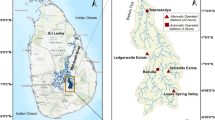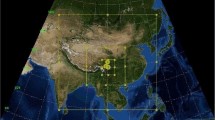Abstract
Numerical weather modelling has gained considerable attention in the field of hydrology especially in un-gauged catchments and in conjunction with distributed models. As a consequence, the accuracy with which these models represent precipitation, sub-grid-scale processes and exceptional events has become of considerable concern to the hydrological community. This paper presents sensitivity analyses for the Weather Research Forecast (WRF) model with respect to the choice of physical parameterization schemes (both cumulus parameterisation (CPSs) and microphysics parameterization schemes (MPSs)) used to represent the ‘1999 York Flood’ event, which occurred over North Yorkshire, UK, 1st–14th March 1999. The study assessed four CPSs (Kain–Fritsch (KF2), Betts–Miller–Janjic (BMJ), Grell–Devenyi ensemble (GD) and the old Kain–Fritsch (KF1)) and four MPSs (Kessler, Lin et al., WRF single-moment 3-class (WSM3) and WRF single-moment 5-class (WSM5)] with respect to their influence on modelled rainfall. The study suggests that the BMJ scheme may be a better cumulus parameterization choice for the study region, giving a consistently better performance than other three CPSs, though there are suggestions of underestimation. The WSM3 was identified as the best MPSs and a combined WSM3/BMJ model setup produced realistic estimates of precipitation quantities for this exceptional flood event. This study analysed spatial variability in WRF performance through categorical indices, including POD, FBI, FAR and CSI during York Flood 1999 under various model settings. Moreover, the WRF model was good at predicting high-intensity rare events over the Yorkshire region, suggesting it has potential for operational use.












Similar content being viewed by others
References
Alam MM (2014) Impact of cloud microphysics and cumulus parameterization on simulation of heavy rainfall event during 7–9 October 2007 over Bangladesh. J Earth Syst Sci 123(2):259–279
Bugaets A, Gonchukov L (2014) Application of WRF-SWAT OpenMI 2.0 based models integration for real time hydrological modelling and forecasting. Geophys Res Abstr 16:EGU2014–EGU4712
Chandrasekar R, Balaji C (2012) Sensitivity of tropical cyclone Jal simulations to physics parameterizations. J Earth Syst Sci 121(4):923–946
Chen F, Kusaka H, Bornstein R, Ching J, Grimmond CSB, Grossman-Clarke S, Loridan T, Manning KW, Martilli A, Miao S, Sailor D, Salamanca FP, Taha H, Tewari M, Wang X, Wyszogrodzki AA, Zhang C (2011) The integrated WRF/urban modelling system: development, evaluation, and applications to urban environmental problems. Int J Climatol 31:273–288. doi:10.1002/joc.2158
Cohen C, McCaul EW Jr (2006) The sensitivity of simulated convective storms to variations in prescribed single-moment microphysics parameters that describe particle distributions, sizes, and numbers. Mon Weather Rev 134:2547–2565
Dudhia J (1989) Numerical study of convection observed during the winter monsoon experiment using a mesoscale two-dimensional model. J Atmos Sci 46(20):3077–3107
Environment Agency (2007) Managing flood risk. Yorkshire Derwent Catchment Flood Management Plan May 2007. www.knowledge-controversies.ouce.ox.ac.uk/Ryedale2/…/DCFMP.pdf. Accessed 29 May 2013
Evans JP, Ekstrom M, Ji F (2012) Evaluating the performance of a WRF physics ensemble over South-East Australia. Clim Dyn 39:1241–1258. doi:10.1007/s00382-011-1244-5
Fovell RG, Su H (2007) Impact of cloud microphysics on hurricane track forecasts. Geophys Res Lett 34, L24810
Fowler H (2005) Are extremes increasing? Changing rainfall patterns in Yorkshire. The Yorkshire and Humber Regional Review Spring 15(1):29–31
Fowler MA, Roebber PJ (2003) Short-range (0–48 h) numerical prediction of convective occurrence, mode, and location. Weather Forecast 18:782–794
Fritsch JM, Carbone RE (2004) Improving quantitative precipitation forecasts in the warm season: a USWRP research and development strategy. Bull Am Meteorol Soc 85(7):955–965
Giorgi F, Bates GT, Nieman SJ (1993) The multiyear surface climatology of a regional atmospheric model over the western United States. J Clim 6:75–95
Givati A, Barry L, Yubao L, Alon R (2012) Using the WRF model in an operational streamflow forecast system for the Jordan River. J Appl Meteorol Climatol 51:285–299. doi:10.1175/JAMC-D-11-082.1
Gochis D, Rasmussen R, Yu W, Ikeda K (2014) Modeling changes in extreme snowfall events in the central rocky mountains region with the fully-coupled WRF-hydro modeling system. Geophys Res Abstr 16:EGU2014–EGU16094
Grell GA (1993) Prognostic evaluation of assumption used by cumulus parameterizations. Mon Weather Rev 121:764–787
Grell GA, Devenyi D (2002) A generalized approach to parameterizing convection combining ensemble and data assimilation techniques. Geophys Res Lett 29(14):1–4. doi:10.1029/2002GL015311
Hong SY, Dudhia J, Chen SH (2004) A revised approach to ice microphysical processes for the bulk parameterization of clouds and precipitation. Mon Weather Rev 132:103–120
Hong SY, Noh Y, Dudhia J (2006) A new vertical diffusion package with an explicit treatment of entrainment processes. Mon Weather Rev 134:2318–2341
Hu M, Nielsen-Gammon JW, Zhang F (2010) Evaluation of three planetary boundary layer schemes in the WRF model. J Appl Meteorol Climatol 49:1831–1844
Ishak A, Bray M, Remesan R, Han D (2012) Seasonal evaluation of rainfall estimation by four cumulus parameterization schemes and their sensitivity analysis. Hydrol Process 26:1062–1078. doi:10.1002/hyp.8194
Janjic ZI (1994) The step-mountain eta coordinate model: further developments of the convection, viscous sublayer and turbulence closure schemes. Mon Weather Rev 122:927–945
Janjic ZI (2000) Comments on “Development and evaluation of a convection scheme for use in climate models”. J Atmos Sci 57:3686
Jolliffe IT, Stephenson DB (2003) Forecast verification: a practitioner’s guide in atmospheric science. John Wiley and Sons, Chichester, p 240
Kain JS (2004) The Kain–Fritsch convective parameterization: an update. J Appl Meteorol 43:170–181
Kain JS, Fritsch JM (1990) A one-dimensional entraining/detraining plume model and its application in convective parameterization. J Atmos Sci 47(23):2784–2802
Kerkhoven E, Gan TY, Shiiba M, Reuter G, Tanaka K (2006) A comparison of cumulus parameterization schemes in a numerical weather prediction model for a monsoon rainfall event. Hydrol Process 20:1961–1978
Kessler E (1969) On the distribution and continuity of water substance in atmospheric circulation. Meteor Monogr no. 32 Amer Meteor Soc 84
Kite GW, Haberlandt U (1999) Atmospheric model data for macroscale hydrology. J Hydrol 217:303–313. doi:10.1016/S0022-1694(98)00230-3
Krishnamurti TN, Kishtawal CM, LaRow TE, Bachiochi DR, Zhang Z et al (1999) Improved weather and seasonal climate forecasts from multi-model superensemble. Science 285:1548–1550
Kuo HL (1974) Further studies of theparameterizations of the influence of cumulusconvection on large scale flow. J Atmos Sci 31:1232–1240
Li X, Pu Z (2008) Sensitivity of numerical simulation of early rapid intensification of Hurricane Emily (2005) to cloud microphysical and planetary boundary layer parameterizations. Mon Weather Rev 136. doi:10.1175/2008MWR2366.1
Lin YL, Farley RD, Orville HD (1983) Bulk parameterization of the snow field in a cloud model. J Clim Appl Meteorol 22:1065–1092
Liong SY, Raghavan SV, Vu MT (2013) Climate change and its impacts on streamflow: WRF and SCE-optimized SWAT models. Data Assimilation Atmos Ocean Hydrol Appl II:411–428
Liu J, Bray M, Han D (2012) Sensitivity of the Weather Research and Forecasting (WRF) model to downscaling ratios and storm types in rainfall simulation. Hydrol Process 26:3012–3031
Luo Y, Wang Y, Wang H, Zheng Y, Morrison H (2010) Modelling convective-stratiform precipitation processes on a Mei-Yu front with the Weather Research and Forecasting model: comparison with observations and sensitivity to cloud microphysics parameterizations. J Geophys Res 115, D18117
Mooney PA, Mulligan FJ, Fealy R (2013) Evaluation of the sensitivity of the Weather Research and Forecasting model to parameterization schemes for regional climates of Europe over the period 1990–95. J Climate 26:1002–1017. doi:10.1175/JCLI-D-11-00676.1
Nicholas EW, Alan FH, Mimi H, Shara IF, Jessica DL (2013) Intercomparison of meteorological forcing data from empirical and mesoscale model sources in the North Fork American River Basin in Northern Sierra Nevada, California. J Hydrometeorol 14:677–699. doi:10.1175/JHM-D-12-0102.1
Pall JS, Eltahir EAB (2001) Pathways relating soil moisture conditions to future summer rainfall within a model of the land-atmosphere system. J Clim 14:1227–1242
Ratna SB, Ratnam JV, Behera SK, Rautenbach CJD, Ndarana T, Takahashi K, Yamagata T (2014) Performance assessment of three convective parameterization schemes in WRF for downscaling summer rainfall over South Africa. Clim Dyn 42(11-12):2931–2953. doi:10.1007/s00382-013-1918-2
Remesan R, Bellerby T, Frostick L (2013) Hydrological modelling using data from monthly GCMs in a regional catchment. Hydrol Process. doi:10.1002/hyp.9872
Ruiz JJ, Saulo C (2010) WRF model sensitivity to choice of parameterization over South America: validation against surface variables. Mon Weather Rev 138:3342–3355
Ryedale Natural History Society (RNHS) (2013) The March floods. http://www.ryenats.org.uk/flood99.htm. Accessed 23 May 2013)
Salimun E, Tangang F, Juneng L (2010) Simulation of heavy precipitation episode over eastern Peninsular Malaysia using MM5: sensitivity to cumulus parameterization schemes. Meteorol Atmos Phys 107:33–49
Seuffert G, Gross P, Simmer C, Wood EF (2002) The influence of hydrologic modeling on the predicted local weather: two-way coupling of a mesoscale weather prediction model and a land surface hydrologic model. J Hydrometeorol 3:505–523. doi:10.1175/1525-7541(2002)003<0505:TIOHMO>2.0.CO;2
Skamarock WC, Klemp JB, Dudhia J, Gill DO, Barker DM, Wang W, Powers JG (2005) A description of the advanced research WRF version 2. NCAR Tech. Note/TN-468+STR, 88 pp
Stanski HR, Wilson LJ, Burrows WR (1989) Survey of common verification methods in meteorology. World Weather Watch technical report no. 8, WMO/TD no. 358, WMO, Geneva, 114
Tang C, Dennis RL (2014) How reliable is the offline linkage of Weather Research and Forecasting Model (WRF) and Variable Infiltration Capacity (VIC) model? Glob Planet Chang 116:1–9
Wenhua G, Chung-Hsiung S (2013) A modeling analysis of rainfall and water cycle by the cloud-resolving WRF model over the Western North Pacific. Adv Atmos Sci 30(6):1695–1711
Wilks DS (2006) Statistical methods in atmospheric science, 2nd edn. Academic Press, Burlington, p 627
Wood AW, Leung LR, Sridhar V, Lettenmaier DP (2004) Hydrologic implications of dynamical and statistical approaches to downscaling climate model outputs. Clim Chang 62:189–216
WRF (2013) WRF model users page. http://www.mmm.ucar.edu/wrf/users/
Xiu A, Pleim JE (20010 Development of a land surface model. Part I: application in a mesoscale meteorological model. J Appl Meteor 40:192–209. 10.1175/1520-0450(2001)040<0192:DOALSM>2.0.CO;2
Zhang DL, Zheng WZ, Xue YK (2003) A numerical study of early summer regional climate and weather over LSA-East. Part I: model implementation and verification. Mon Weather Rev 131:1895–1909
Acknowledgements
This study was funded by Yorkshire Forward within the research project ‘Low Carbon and Climate Resilient Regional Economy’ which has the objective of a assessing the impacts of climate change on resources that influence the future regional economy of the Yorkshire–Humberside region in North-East England.
Author information
Authors and Affiliations
Corresponding author
Rights and permissions
About this article
Cite this article
Remesan, R., Bellerby, T., Holman, I. et al. WRF model sensitivity to choice of parameterization: a study of the ‘York Flood 1999’. Theor Appl Climatol 122, 229–247 (2015). https://doi.org/10.1007/s00704-014-1282-0
Received:
Accepted:
Published:
Issue Date:
DOI: https://doi.org/10.1007/s00704-014-1282-0




